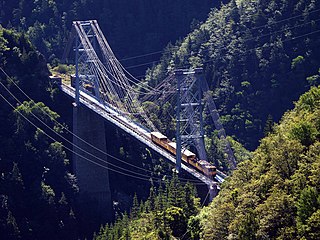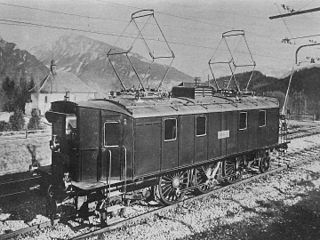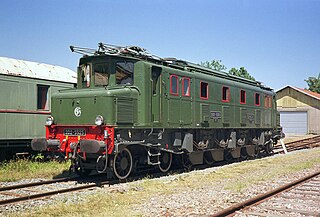
The Compagnie des chemins de fer du Midi, also known in English as the Midi or Southern Railway, was an early French railway company which operated a network of routes in the southwest of the country, chiefly in the area between its main line – which ran from Bordeaux, close to the Atlantic coast, to Sète on the Mediterranean – and the Pyrenees.

The Ligne de Cerdagne, usually referred to as Le Petit Train Jaune, is a 1,000 mm gauge railway that runs from Villefranche-de-Conflent to Latour-de-Carol-Enveitg in the French Pyrenees.

Établissements Billard was a French railway rolling stock construction company founded in 1920 and based in Tours. It specialised in light railbuses and metre gauge and narrow gauge rolling stock. The business ceased trading in 1956 and later became Socofer.
The Chemin de Fer du Blanc-Argent is a 1,000 mm gauge railway in the region of Centre-Val de Loire, France, part of which is still open to traffic, whilst another section is now operated as a heritage railway.
The Prussian G 12.1 was a German steam locomotive built for the Prussian state railways during the First World War and was the largest Prussian freight locomotive with a 2-10-0 wheel arrangement. It had three cylinders, the two outer ones driving the third axle and the inner one the second axle.
The SNCF locomotives BB 101 to BB 180 were a class of 1500 V DC 4-axle electric locomotives originally built for the Chemin de fer de Paris à Orléans in the 1920s. The class were built as part of an order for 200 locomotives of similar types and were initially used on the newly electrified Paris - Vierzon line before being displaced by the SNCF 2D2 5500 class.

The SNCF locomotives BB 201 to BB 220 were a class of 1500 V DC 4-axle electric locomotives originally built for the Chemin de fer de Paris à Orléans in the 1920s.
The SNCF locomotives BB 1321 to BB 1324 were a class of 1500 V DC 4 axle electric locomotives originally built for the Chemin de fer de Paris à Orléans in the 1920s.
The SNCF locomotives BB 1425 to BB 1440 were a class of 1500 V DC 4 axle electric locomotives originally built for the Chemin de fer de Paris à Orléans in the 1920s.

The SNCF BB 1280 class were a class of 600 V DC 4 axle Bo′Bo′ electric locomotives, formerly Compagnie du chemin de fer de Paris à Orléans machines, initially built for an underground section of line connecting the Gare d'Austerlitz to the Quai d'Orsay in inner Paris. The locomotives were converted for 1500 V DC use in the 1930s, and renumbered PO E.281 to E.293. They were absorbed by the SNCF, and operated as shunters until the late 1960s.

The 2BB2 400 class were two electric locomotives built in 1926 for the Paris Orléans (PO) railway of France.

The SNCF X 3800 class are diesel railcars with an elevated off-center control cabin. It is often said that they were nicknamed “Picassos” because the off-center cabin was reminiscent of paintings by Pablo Picasso featuring faces where the eyes and nose were completely offset. The nickname may though have come from the number of early paint schemes applied to the class.

SNCF 232.P.1 was an experimental prototype high-pressure steam locomotive ordered by the Chemins de fer du Nord, but delivered to the Société nationale des chemins de fer français (SNCF) in 1939. It was the first and only member of SNCF's first class of 4-6-4 or Hudson type of locomotives.
Ceinture 5001 to 5012 were a class of 2-10-2T tank locomotives of the Syndicat d'Exploitation des Chemins de fer de Ceinture de Paris. They were used for hauling freight trains on the Grande Ceinture line in Paris, and later the Région Nord.
The SNCF 232.Q.1 was an experimental prototype steam locomotive of the Société nationale des chemins de fer français (SNCF) which entered service in 1940. It was Baltic or 4-6-4 locomotive.

The 2C2 3100 were a class of electric locomotives of the Chemins de fer du Midi, France. They were ordered in 1914 but, because of the First World War, deliveries did not begin until 1923. They were designed for alternating current at 12 kV, 16⅔ Hz but, before construction, they were re-designed for direct current at 1,500 V.

Midi E 3301 was a prototype electric locomotive of Class E 3300 designed for the Chemins de fer du Midi, France. Because of poor performance, it was refused by the Compagnie du Midi and was re-deployed to Swiss railways. On 1 May 1919, it was classified Fb 2/5 11001 and, in 1920, it became experimental locomotive Be 2/5 11001 of the Swiss Federal Railways (SBB).

The 2D2 5500 were electric locomotives operated by the Compagnie du chemin de fer de Paris à Orléans, then SNCF in France, in operation from 1933 to 1980.
The Type 032 T is a class of steam locomotives, first used on the Chemins de fer du Midi, that were still in service when the SNCF was founded. The units had several designations during their careers.

The SNCF Class BB 1600 were a class of 1,500 V DC electric locomotives built for the Pau – Lourdes line of the Chemins de fer du Midi by CEF. Numbered E 4001 to E 4050 at Midi, they became BB 4500 – B4550 when SNCF was created, then were relegated to shunting duties under the numbers BB 1601 to BB 1650 in the 1950s.












